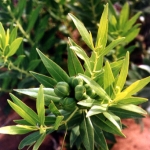| Common Name: |
Queen's Delight |
| Other Names: |
Yaw Root |
| Botanical Name: |
Stillingia sylvatica |
| Genus: |
Stillingia |
| Family: |
Euphorbiaceae |
| Native Location: |
Eastern N America |
| Cultivation: |
Dry, sandy, acid soil in sun or partial shade. |
| Propagation: |
By seed sown in autumn or spring; by division in spring. |
| Harvest: |
Roots are lifted in late summer and early autumn, and dried for use in decoctions, elixirs, liquid extracts, tablets and tinctures. They should be processed as soon as possible after harvesting because their properties deteriorate rapidly. Dried roots should be discarded after two years. |
| Height: |
60cm-1.2m (2-4ft) |
| Width: |
60-90cm (24-36in) |
| Hardiness: |
Z8-10 |
| Parts Used: |
Roots |
| Properties: |
A bitter, acrid, tonic herb with an unpleasant odor. It is alterative, diuretic, expectorant, and laxative. |
| Medicinal Uses: |
Internally for syphilis, and for liver, genito-urinary, and bronchial complaints. Combined with other depurative or alterative herbs, e.g. Trifolium pratense (See, Red Clover), in tonic and "blood purifying" formulas. |
| Warning: |
Excess causes diarrhea and vomiting.
For use by qualified practioners only. |
| Bibliography: |
Encyclopedia of Herbs by Deni Brown Copyright © 1995, 2001 Dorling Kindersley Limited Pg 375 |

